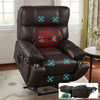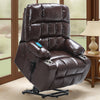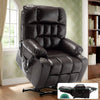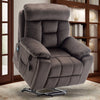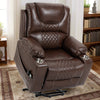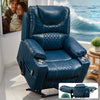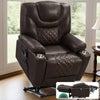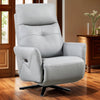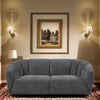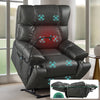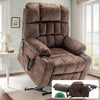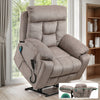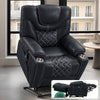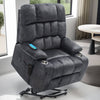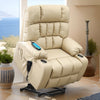Understanding the Importance of Ergonomic Support for Seniors
The Role of Recliner Cushions in Preventing Pressure Ulcers
Recliner cushions play a vital role in preventing pressure ulcers for seniors. These special cushions help distribute weight evenly, reducing pressure on sensitive areas. They provide comfort and support, especially for those who spend long hours sitting.

Quality cushions can:
- Reduce friction and shear forces
- Promote better blood circulation
- Minimize skin breakdown
- Alleviate pain and discomfort
For seniors with limited mobility, proper cushioning is crucial. It helps maintain skin integrity and prevents the formation of painful sores. Investing in the right recliner cushion can significantly improve an elderly person's comfort and health.
How Ergonomic Cushions Can Improve Quality of Life
Ergonomic cushions can greatly enhance the quality of life for seniors. These specially designed cushions offer more than just comfort. They provide essential support for aging bodies, leading to numerous benefits:
- Reduced back pain and improved posture
- Enhanced comfort during long sitting periods
- Better sleep quality when used in recliners
- Increased independence and mobility
- Reduced risk of developing pressure sores
By supporting proper body alignment, ergonomic cushions help seniors maintain their independence. They can sit comfortably for longer periods, enjoying activities they love. This improved comfort can lead to better mental health and overall well-being for older adults.
The Connection Between Seating and Mobility in Older Age
Proper seating plays a crucial role in maintaining mobility as we age. Good posture and support while sitting can have a significant impact on an elderly person's ability to move. Here's how seating affects mobility:
- Reduces muscle fatigue and strain
- Promotes better balance when standing up
- Helps maintain flexibility in joints
- Encourages proper spine alignment
- Prevents the development of poor posture habits
When seniors have comfortable, supportive seating, they're more likely to stay active. This can help preserve their strength and flexibility. Good seating also makes it easier to get up and move around. This connection between seating and mobility is vital for maintaining independence in older age.
Key Considerations When Purchasing Recliner Cushions
Assessing the Quality and Materials of Cushions
When choosing recliner cushions for the elderly, quality and materials are crucial factors. High-quality cushions can provide better support and last longer. Here are key points to consider:

- Foam density: Higher density usually means better support and durability
- Memory foam: Conforms to body shape for personalized comfort
- Gel-infused foam: Helps regulate temperature for added comfort
- Breathable fabrics: Prevent heat build-up and moisture
- Waterproof covers: Protect the cushion from spills and accidents
Look for cushions with multiple layers of foam for optimal support. The cover material should be soft yet durable. Avoid cushions with thin, flimsy materials that won't hold up to daily use. Quality cushions may cost more upfront but can save money in the long run.
Determining the Right Cushion Fit for Your Senior Loved One
Finding the right cushion fit is essential for your senior loved one's comfort and safety. A properly fitted cushion can prevent slipping and provide optimal support. Consider these factors:
- Chair size: Measure the seat to ensure the cushion fits properly
- User's weight: Choose a cushion that can support their weight
- Height: Ensure the cushion allows feet to rest comfortably on the floor
- Medical conditions: Consider any specific needs, like pressure relief
- Ease of cleaning: Look for removable, washable covers
It's best to have your loved one try different cushions if possible. Pay attention to their feedback about comfort and ease of use. Remember, the right fit can greatly improve their sitting experience and overall well-being.
Incorporating Cushions into a Comprehensive Elderly Care Plan
Recliner cushions should be part of a larger care plan for seniors. They work best when combined with other strategies to promote comfort and health. Here's how to integrate cushions into a comprehensive care plan:
- Regular repositioning: Even with good cushions, changing positions is important
- Exercise: Encourage gentle movements to maintain strength and flexibility
- Skin checks: Monitor for any signs of pressure or irritation
- Nutrition: A healthy diet supports skin health and overall well-being
- Hydration: Proper fluid intake is crucial for skin elasticity
Work with healthcare providers to create a tailored plan. This may include physical therapy or occupational therapy assessments. Remember, cushions are just one part of keeping seniors comfortable and healthy as they age.
Navigating the Market: Top Recliner Cushions for Seniors in the United States
Reviewing the Best Recliner Cushions According to Expert Opinions
Experts in senior care and ergonomics have identified several top-rated recliner cushions. These options stand out for their quality, comfort, and support. Here are some highly recommended choices:

- ComfiLife Gel Enhanced Seat Cushion
- Everlasting Comfort Seat Cushion
- Purple Royal Seat Cushion
- ROHO Mosaic Cushion
- Tempur-Pedic Seat Cushion
These cushions offer features like pressure relief, temperature regulation, and durability. They have received positive feedback from both users and healthcare professionals. When choosing, consider the specific needs of your senior loved one. What works best can vary from person to person.
Comparing Price Points and Warranties
Price and warranty are important factors when selecting recliner cushions. Here's a general overview:
- Budget-friendly options: $20 - $50
- Mid-range cushions: $50 - $100
- High-end, specialized cushions: $100 - $300+
Warranties can vary greatly:
- Basic cushions: 30-day to 1-year warranty
- Premium options: 2-5 year warranties
- Some brands offer lifetime warranties
Remember, a higher price doesn't always mean better quality. Look for cushions that offer good value for their features. Check warranty terms carefully. Some cover only manufacturing defects, while others are more comprehensive.
Understanding Insurance and Medicare Coverage for Cushions
Insurance and Medicare coverage for recliner cushions can be complex. Here's a brief overview:
- Medicare Part B may cover pressure-reducing cushions if medically necessary
- A doctor's prescription and documentation of medical need are usually required
- Coverage is typically for specific types of cushions, not all varieties
- Copayments may apply, even with coverage
Private insurance policies vary widely in their coverage. Some may offer coverage similar to Medicare, while others may not cover cushions at all. It's important to:
- Check with your insurance provider about specific coverage details
- Ask about any required documentation or pre-approval processes
- Understand any out-of-pocket costs you may face
Always verify coverage before making a purchase. This can help avoid unexpected expenses and ensure you get the support you need.








